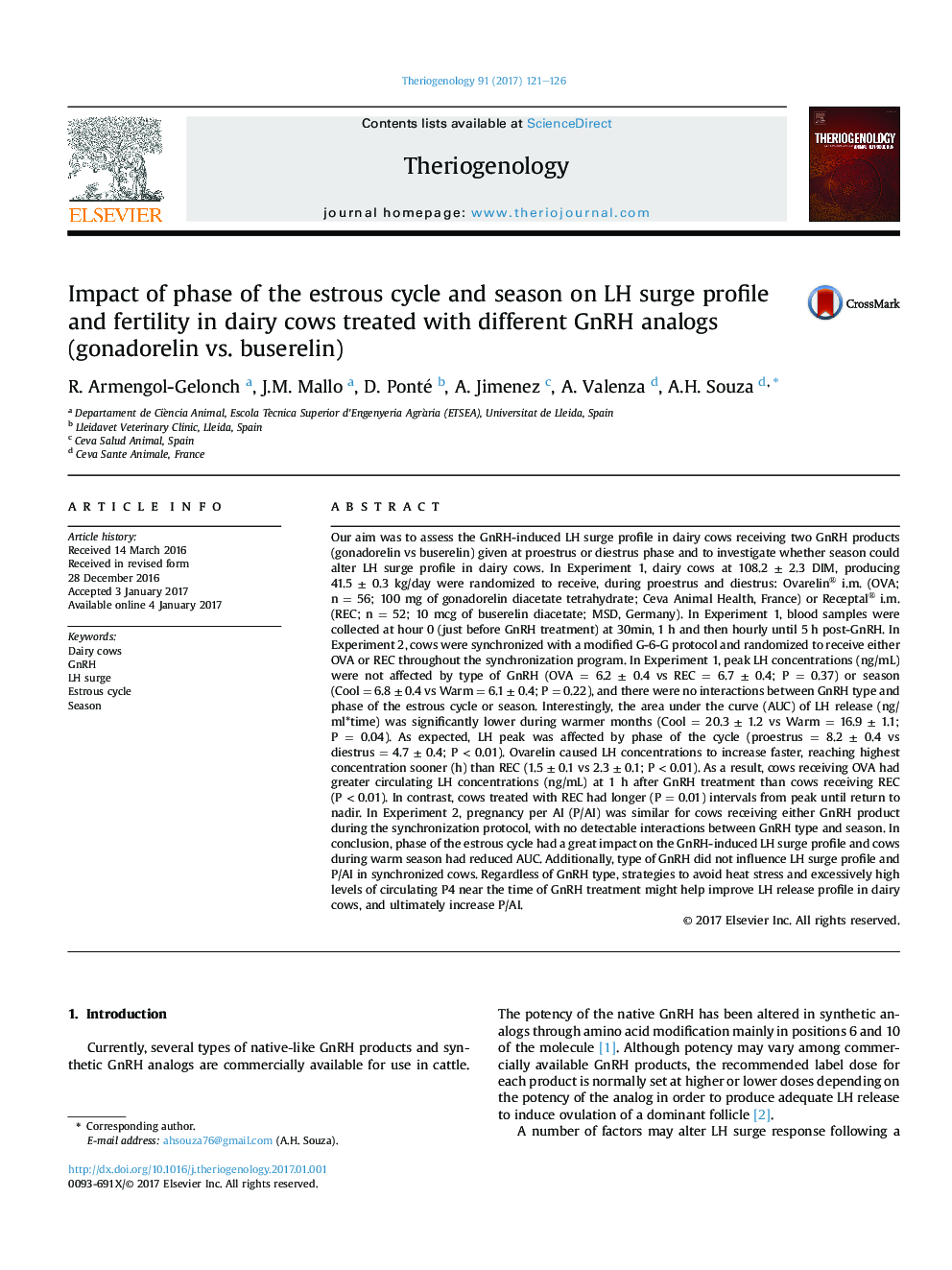| کد مقاله | کد نشریه | سال انتشار | مقاله انگلیسی | نسخه تمام متن |
|---|---|---|---|---|
| 5523487 | 1546078 | 2017 | 6 صفحه PDF | دانلود رایگان |

- This is one of the first manuscripts addressing the possible interactions between heat-stress and diestrus on LH profile in dairy cows.
- Our results on LH release profile are also backed by large field fertility study.
- In addition, we compared two commonly used GnRH products to help guide decision making while utilizing timed AI protocols.
Our aim was to assess the GnRH-induced LH surge profile in dairy cows receiving two GnRH products (gonadorelin vs buserelin) given at proestrus or diestrus phase and to investigate whether season could alter LH surge profile in dairy cows. In Experiment 1, dairy cows at 108.2 ± 2.3 DIM, producing 41.5 ± 0.3 kg/day were randomized to receive, during proestrus and diestrus: Ovarelin® i.m. (OVA; n = 56; 100 mg of gonadorelin diacetate tetrahydrate; Ceva Animal Health, France) or Receptal® i.m. (REC; n = 52; 10 mcg of buserelin diacetate; MSD, Germany). In Experiment 1, blood samples were collected at hour 0 (just before GnRH treatment) at 30min, 1 h and then hourly until 5 h post-GnRH. In Experiment 2, cows were synchronized with a modified G-6-G protocol and randomized to receive either OVA or REC throughout the synchronization program. In Experiment 1, peak LH concentrations (ng/mL) were not affected by type of GnRH (OVA = 6.2 ± 0.4 vs REC = 6.7 ± 0.4; P = 0.37) or season (Cool = 6.8 ± 0.4 vs Warm = 6.1 ± 0.4; P = 0.22), and there were no interactions between GnRH type and phase of the estrous cycle or season. Interestingly, the area under the curve (AUC) of LH release (ng/ml*time) was significantly lower during warmer months (Cool = 20.3 ± 1.2 vs Warm = 16.9 ± 1.1; P = 0.04). As expected, LH peak was affected by phase of the cycle (proestrus = 8.2 ± 0.4 vs diestrus = 4.7 ± 0.4; P < 0.01). Ovarelin caused LH concentrations to increase faster, reaching highest concentration sooner (h) than REC (1.5 ± 0.1 vs 2.3 ± 0.1; P < 0.01). As a result, cows receiving OVA had greater circulating LH concentrations (ng/mL) at 1 h after GnRH treatment than cows receiving REC (P < 0.01). In contrast, cows treated with REC had longer (P = 0.01) intervals from peak until return to nadir. In Experiment 2, pregnancy per AI (P/AI) was similar for cows receiving either GnRH product during the synchronization protocol, with no detectable interactions between GnRH type and season. In conclusion, phase of the estrous cycle had a great impact on the GnRH-induced LH surge profile and cows during warm season had reduced AUC. Additionally, type of GnRH did not influence LH surge profile and P/AI in synchronized cows. Regardless of GnRH type, strategies to avoid heat stress and excessively high levels of circulating P4 near the time of GnRH treatment might help improve LH release profile in dairy cows, and ultimately increase P/AI.
Journal: Theriogenology - Volume 91, 15 March 2017, Pages 121-126